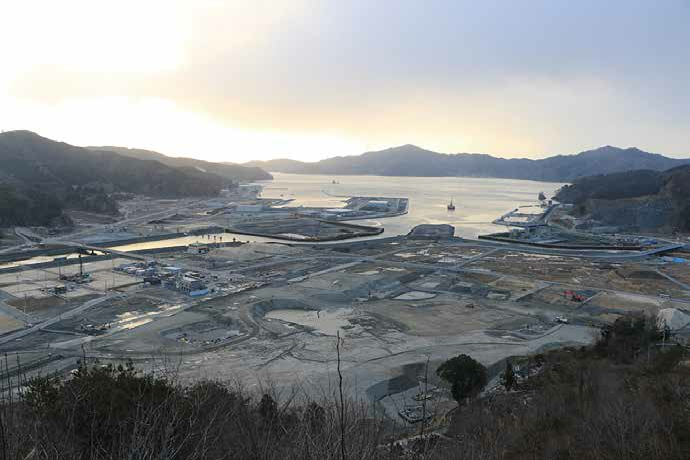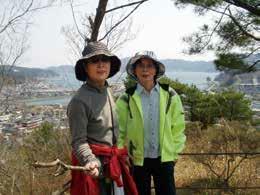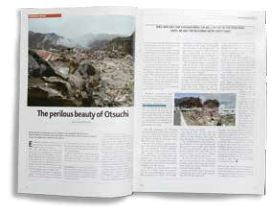Issue:

Above, a March 2015 view of the progress of the incremental landfill operations in central Otsuchi that began in 2013 following debris clearing. To the left is the district of Ando, with its fishing jetty protruding into the harbor; across the Kozuchi River to the right is Nobematsu, now connected by a temporary span that replaced the original bridge and its six-meter high floodgates.
The story of a tsunami battered town trying to get back on its feet is a tale of struggle, conflict, bureaucracy and, yes, hope.
Not all has gone smoothly in the town of Otsuchi as it struggles to recover from the tsunami devastation wreaked upon it five years ago. (See my story, “The Perilous Beauty of Otsuchi,” in the April, 2011 edition of No. 1 Shimbun.) For starters, the loss of its mayor, Koki Kato, together with key department heads and the more than 30 experienced staff that made up a quarter of the town’s civil servants meant that there was no one to immediately get to work on a master plan for recovery. It wasn’t until January 2012 that a draft was finally completed, under a new mayor, Yutaka Ikarigawa.
Mayor Ikarigawa was faced with a number of tough issues, from organizing housing for survivors to sorting out land problems for the dead and missing. And over the next several years some progress was made, including a partial revival of the fisheries industry and construction of new residences to replace the temporary structures housing survivors.
But two key projects in the master plan led to discontent, as the long-range view of those who had forged the plan clashed with the more immediate desires of the survivors. One was a plan to raise the ground level in central Otsuchi by 2.5 meters; the other, to build a huge seawall 14.5 meters high.
The plan to raise the ground level, intended as a safeguard against smaller tsunami and future rises in the sea level, will bring it up to the level of the entry road from National Highway 45 and the new town offices, formerly the burned-out elementary school. It is a six-year project, started in 2012 with debris clearing, followed by incremental landfill scheduled through 2016, and finally ending with a year of waiting for it all to settle before rebuilding can begin in 2018. But after months of uncertainty following the tsunami, many displaced townspeople could not wait another six years and departed for other locales.
THE PLAN TO BUILD the huge seawall favored by Tokyo bureaucrats, but with the responsibility in the hands of the prefecture has yet to get underway. Strong doubts have been expressed about its usefulness in protecting the town against future, perhaps even larger, tsunami. Critics also say that any concrete structure of this kind will deteriorate and require replacement in 50 years, which will mean another huge outlay of tax money. They prefer an enhanced system of tsunami alerts and evacuation routes, which are already included in the master plan for central Otsuchi.
In particular, opposition was voiced by the fisheries folk in Akahama, which is also home to Tokyo University’s International Coastal Research Center (ICRC). Akahama also has a walkway to Horaijima, an islet known to most Japanese from a popular 1960s NHK puppet program Hyokkori Hyotan-jima that featured a popular theme song. Many of its residents were lost in the 2011 tsunami, opponents said, because the earlier seawall at 6.5 meters had blocked their view of the “drawback” receding water from the harbor that preceded the onslaught that would have alerted them to seek higher ground. In their opinion, a seawall 14.5 meters high would just make such future situations even worse.
Opponents had their point made for them with the release in April, 2015, of a documentary by director Haruko Konishi, titled Akahama Rock’n Roll. The film makes a strong case for the more traditional fishery environment rather than a high seawall. Even Akie Abe, the prime minister’s wife, expressed sympathy for the opponents’ cause at a UN Disaster Prevention Conference in Sendai last year, according to newspaper reports.
After losing almost 10 percent of its 15,239 citizens to the tsunami (one of the largest losses among the affected towns), Otsuchi’s population continues to drop. In fact, it had fallen by 23.2 percent by the end of 2015, according to a report in Asahi Shimbun. This is far and away the largest decrease among the coastal communities affected by the tsunami, with the next highest being Rikuzentakata at 15.2 percent. The reasons were various. Some former residents who had evacuated to inland towns just opted not to return to the gutted community. But the biggest hit came from the post-tsunami exodus of younger people looking for work or schooling elsewhere.
Aside from cleanup and landfill work and rebuilding, long-term jobs that can help persuade locals to stay are in short supply to this day. Although the partially recovered fishery industry continues to offer opportunities, these jobs seem to offer little appeal for the younger generation. And though MAST Otsuchi’s major shopping center that attracted many residents of surrounding communities reopened in December 2011, its consumer base began eroding after 2013 as a result of increasing competition from shopping centers in nearby towns, especially the Aeon shopping center in nearby Kamaishi.
Driving home the reality of a shrinking population was the merger of three elementary schools in April 2013. Today, Otsuchi has become a town occupied mostly by retirees and transient workers.
TO ENCOURAGE REBUILDING IN Otsuchi, government subsidies totaling ¥5 million are on offer to qualifying families. But no rebuilding can take place in the town center until 2018, and those who want to build in other areas face escalating construction costs. That is assuming, of course, that a construction company can be found, for even local governments are having difficulty in obtaining bids for their projects. Costs have been rising not only from demand in the stricken areas of Sanriku, but also from the general upgrading of the national infrastructure by the Abe administration, a situation further aggravated by the decision to hold the 2020 Summer Olympics in Tokyo.
These developments have fed growing cynicism among survivors all along the Sanriku coast. Many sense they are being abandoned, or at least having their futures downgraded in favor of other government projects. These feelings have only increased following the decision to hold the Olympics. And when the central government recently announced an end to the intensive five-year phase of Tohoku recon-struction and a reduction in such funds for the next five-year phase from fiscal 2016, this only added to their pessimism.


Before and the aftermath
Top, the author’s wife Atsuko and sister-in-law, Noriko, hiking in 2009 with Otsuchi harbor and bay in the background. Above, Charles’ No. 1 Shimbun feature on Otsuchi in the April 2011 earthquake special.
Despite these negatives, one of our family members, a brother-in- law in his mid-60s who spent most of his adult life in Tokyo, returned to Otsuchi after retiring in 2015. He now works part time to supplement his retirement income while looking for new opportunities in his hometown. So far he has found none.
Still, all is not lost, and perhaps the long-range planning of Ikarigawa’s experts, representing central and prefectural governments as well as academia and knowledgeable locals, will see a new dawning in Otsuchi. But he won’t be in a position to lead it. Difficulties with his master plan’s implementation eventually led to his defeat in the August 2015 election. His victorious opponent, Kozo Hirano, ran on a platform calling for a review of the planned reconstruction projects.
In addition to the slow but ongoing recovery of the fisheries, positive signs include the revival of the old railway line by Sanriku Railways in 2021 and the completion of the new Sanriku coastal expressway in 2022. Both will make Otsuchi more accessible for commerce and tourism as well as much easier to live in, especially for students who had pleaded for a return of the railway to enable commuting to schools in other towns. This should also increase the town’s attraction for families with school-age children.
OUR HOME WAS AMONG the 3,359 in Otsuchi destroyed by the tsunami. My wife Atsuko and I plan to begin rebuilding in 2018 on our small parcel of land at the southern edge of the central district, which will allow us to continue our retirement that began there in 2004. It will again put us within a five-minute walk of the family gravesite at Dainenji, and give us easy access to that mountain’s scenic hiking trail.
Sadly, we will no longer be joined on these hikes by our favorite companion, Atsuko’s elder sister, Noriko, who had lived nearby. She and her husband, Yuji, were both lost to the tsunami. Her remains were not identified until August of 2011 and his were never found. The addition of her ashes to the family gravesite has made our visits for the annual Obon Buddhist observances even more poignant.
Half of our neighbors were also lost to the tsunami and, apparently, none among the surviving families will return. So we will start afresh with new neighbors, but bedrock support from Atsuko’s brother and other relatives as well as friends dating back to her childhood.
And with any luck, some of our favorite local shops will restart their businesses. In particular, I would like to see the reappearance of Akabu Sakaya, which made it a point to keep my favorite gin and vermouth in stock.
Charles Pomeroy retired from journalism 12 years ago. He is the author of Tsunami Reflections Otsuchi Remembered.

